I greet you cordially.
As in established by me poll for a decisive lead, a mini metal detector for self-assembly has come forward, this is where we will start a series of articles devoted to gadgets.
At a Chinese auction, you can buy this gadget for about six Polish zlotys.
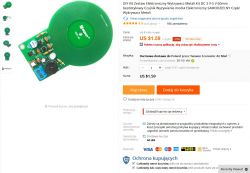
It's a very simple layout, but it does the job pretty well.
I think the diagram will explain everything:
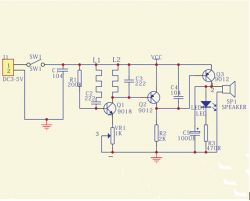
As you can see in the diagram above - it can be done without a microcontroller. :)
What we get in the package:
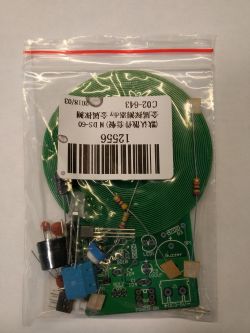
As you can see - there is a regular zip bag, not an ESD Free bag, but what can be damaged here.
After pouring the content onto the table, we don't have too many elements.

Let's start with the technical parameters:
1. The supply voltage is from 3VDC to 5VDC.
2. Power is supplied to the ARK connector. The polarity is described on the PCB.
3. The device consumes approx. 40mA during operation and approx. 5mA in standby mode.
4. The declared "range" is 60mm.
5. Detection of a ferromagnetic object is signaled by a LED diode (it lights up) and a buzzer squeaking.
The whole system consists of literally a dozen or so elements, the most important of which is the PCB, which is also a double coil and acts as a probe.
Apart from the plate, we also have:
- two 0.022uF ceramic capacitors (C2, C3).
- two S9012 transistors (Q2, Q3).
- two 0.1uF ceramic capacitors (C1, C4).
- 470Ohm resistor (R3).
- 2kOhm resistor (R2).
- 200kOhm resistor (R1).
- 100Ohm mounting potentiometer (VR1).
- 100uF electrolytic capacitor (C5).
- a red 5mm LED (LED1).
- S9018 transistor (Q1).
- 6mm x 5mm bistable power switch (SW1).
- 12mm diameter buzzer (SP1).
- two-pin ARK power socket (J1).
Time for some assembly photos. As usual, we start with soldering the lowest elements.
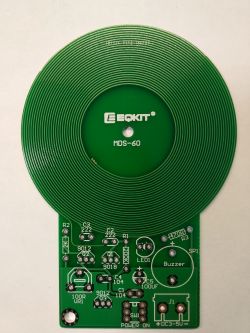
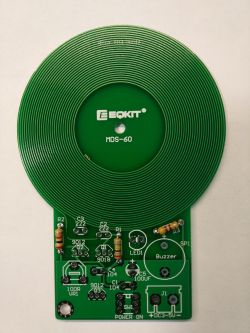
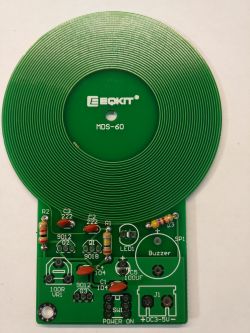
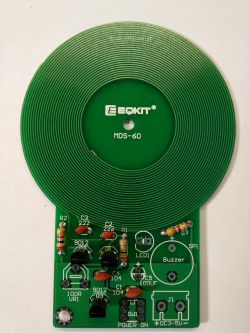
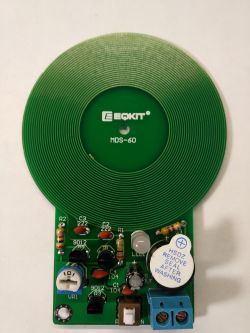
The assembly of the system is very easy. All components are clearly and legibly labeled on the PCB.
After assembly and commissioning, I immediately say that it is only a gadget.
Below is a video of the operation of the device:
I adjusted the system as much as possible. Another brush of the adjustment potentiometer makes the system catch everything possible from the air. Hence, it squeaks endlessly.
In my humble opinion, this chip can only work as an interesting gadget for very beginners and very young future electronics. I quietly hoped that the toto would be useful for detecting wires in the walls, when trying to "hang a picture", but if at 1.5cm - 3cmplaster this gadget is doing better or worse, in the case of plasterboard (where the wires are often a few inches below the surface) it is much worse.
In a word, it is a toy that primarily has educational value.
As in established by me poll for a decisive lead, a mini metal detector for self-assembly has come forward, this is where we will start a series of articles devoted to gadgets.
At a Chinese auction, you can buy this gadget for about six Polish zlotys.

It's a very simple layout, but it does the job pretty well.
I think the diagram will explain everything:

As you can see in the diagram above - it can be done without a microcontroller. :)
What we get in the package:

As you can see - there is a regular zip bag, not an ESD Free bag, but what can be damaged here.
After pouring the content onto the table, we don't have too many elements.

Let's start with the technical parameters:
1. The supply voltage is from 3VDC to 5VDC.
2. Power is supplied to the ARK connector. The polarity is described on the PCB.
3. The device consumes approx. 40mA during operation and approx. 5mA in standby mode.
4. The declared "range" is 60mm.
5. Detection of a ferromagnetic object is signaled by a LED diode (it lights up) and a buzzer squeaking.
The whole system consists of literally a dozen or so elements, the most important of which is the PCB, which is also a double coil and acts as a probe.
Apart from the plate, we also have:
- two 0.022uF ceramic capacitors (C2, C3).
- two S9012 transistors (Q2, Q3).
- two 0.1uF ceramic capacitors (C1, C4).
- 470Ohm resistor (R3).
- 2kOhm resistor (R2).
- 200kOhm resistor (R1).
- 100Ohm mounting potentiometer (VR1).
- 100uF electrolytic capacitor (C5).
- a red 5mm LED (LED1).
- S9018 transistor (Q1).
- 6mm x 5mm bistable power switch (SW1).
- 12mm diameter buzzer (SP1).
- two-pin ARK power socket (J1).
Time for some assembly photos. As usual, we start with soldering the lowest elements.





The assembly of the system is very easy. All components are clearly and legibly labeled on the PCB.
After assembly and commissioning, I immediately say that it is only a gadget.
Below is a video of the operation of the device:
I adjusted the system as much as possible. Another brush of the adjustment potentiometer makes the system catch everything possible from the air. Hence, it squeaks endlessly.
In my humble opinion, this chip can only work as an interesting gadget for very beginners and very young future electronics. I quietly hoped that the toto would be useful for detecting wires in the walls, when trying to "hang a picture", but if at 1.5cm - 3cmplaster this gadget is doing better or worse, in the case of plasterboard (where the wires are often a few inches below the surface) it is much worse.
In a word, it is a toy that primarily has educational value.
Cool? Ranking DIY





